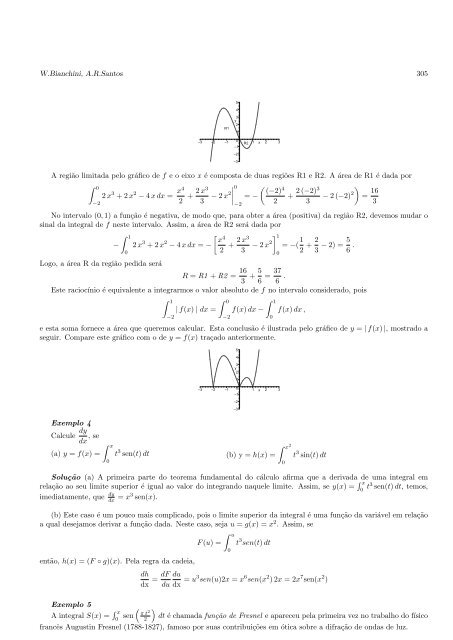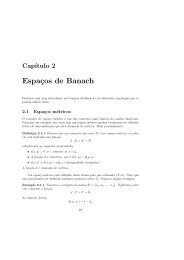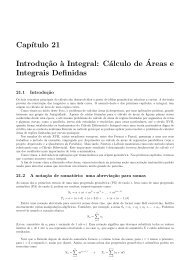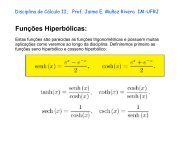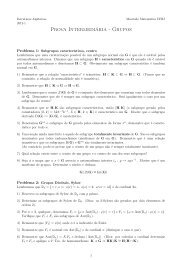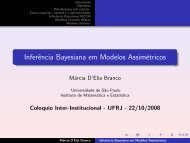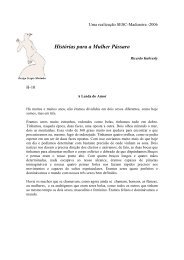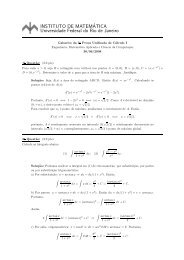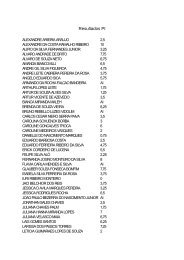Capítulo 22 - Instituto de Matemática - UFRJ
Capítulo 22 - Instituto de Matemática - UFRJ
Capítulo 22 - Instituto de Matemática - UFRJ
You also want an ePaper? Increase the reach of your titles
YUMPU automatically turns print PDFs into web optimized ePapers that Google loves.
W.Bianchini, A.R.Santos 305<br />
R1<br />
5<br />
4<br />
3<br />
y<br />
2<br />
1<br />
–3 –2 –1 0<br />
–1<br />
R2 1 x 2 3<br />
A região limitada pelo gráfico <strong>de</strong> f e o eixo x é composta <strong>de</strong> duas regiões R1 e R2. A área <strong>de</strong> R1 é dada por<br />
∫ 0<br />
2 x 3 + 2 x 2 − 4 x dx = x4<br />
0<br />
(<br />
2 x3 <br />
4<br />
+ − 2 x2<br />
(−2) 2 (−2)3<br />
2 3 = − + − 2 (−2)<br />
2 3<br />
2<br />
)<br />
= 16<br />
3<br />
−2<br />
–2<br />
–3<br />
No intervalo (0, 1) a função é negativa, <strong>de</strong> modo que, para obter a área (positiva) da região R2, <strong>de</strong>vemos mudar o<br />
sinal da integral <strong>de</strong> f neste intervalo. Assim, a área <strong>de</strong> R2 será dada por<br />
∫ 1<br />
− 2 x 3 + 2 x 2 [ ]1<br />
4 x 2 x3<br />
− 4 x dx = − + − 2 x2 = −(<br />
2 3 1 2 5<br />
+ − 2) =<br />
2 3 6 .<br />
0<br />
Logo, a área R da região pedida será<br />
R = R1 + R2 = 16 5 37<br />
+ =<br />
3 6 6 .<br />
Este raciocínio é equivalente a integrarmos o valor absoluto <strong>de</strong> f no intervalo consi<strong>de</strong>rado, pois<br />
∫ 1<br />
−2<br />
| f(x) | dx =<br />
∫ 0<br />
−2<br />
−2<br />
f(x) dx −<br />
∫ 1<br />
0<br />
0<br />
f(x) dx ,<br />
e esta soma fornece a área que queremos calcular. Esta conclusão é ilustrada pelo gráfico <strong>de</strong> y = | f(x) |, mostrado a<br />
seguir. Compare este gráfico com o <strong>de</strong> y = f(x) traçado anteriormente.<br />
Exemplo 4<br />
Calcule dy<br />
, se<br />
dx<br />
(a) y = f(x) =<br />
∫ x<br />
0<br />
5<br />
4<br />
3<br />
y<br />
2<br />
1<br />
–3 –2 –1 0<br />
–1<br />
1 x 2 3<br />
t 3 sen(t) dt (b) y = h(x) =<br />
–2<br />
–3<br />
∫ x 2<br />
0<br />
t 3 sin(t) dt<br />
Solução (a) A primeira parte do teorema fundamental do cálculo afirma que a <strong>de</strong>rivada <strong>de</strong> uma integral em<br />
relação ao seu limite superior é igual ao valor do integrando naquele limite. Assim, se y(x) = ∫ x<br />
0 t3 sen(t) dt, temos,<br />
imediatamente, que dy<br />
dx = x3 sen(x).<br />
(b) Este caso é um pouco mais complicado, pois o limite superior da integral é uma função da variável em relação<br />
a qual <strong>de</strong>sejamos <strong>de</strong>rivar a função dada. Neste caso, seja u = g(x) = x2 . Assim, se<br />
então, h(x) = (F ◦ g)(x). Pela regra da ca<strong>de</strong>ia,<br />
F (u) =<br />
∫ u<br />
0<br />
t 3 sen(t) dt<br />
dh dF du<br />
=<br />
dx du dx = u3sen(u)2x = x 6 sen(x 2 ) 2x = 2x 7 sen(x 2 )<br />
Exemplo 5<br />
A integral S(x) = ∫ x<br />
0 sen<br />
( )<br />
2<br />
π t<br />
2 dt é chamada função <strong>de</strong> Fresnel e apareceu pela primeira vez no trabalho do físico<br />
francês Augustin Fresnel (1788-1827), famoso por suas contribuições em ótica sobre a difração <strong>de</strong> ondas <strong>de</strong> luz.


